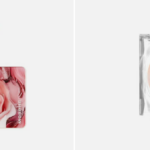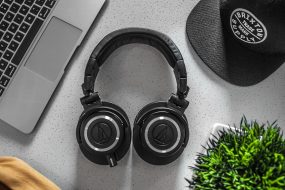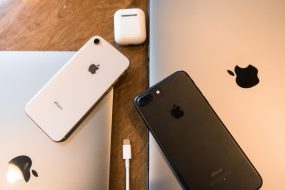
Introduced on September 14, 2021, the iPhone 13 and iPhone 13 mini are Apple’s newest flagship iPhones at the more affordable end, and are being sold alongside the more expensive iPhone 13 Pro and iPhone 13 Pro Max. The iPhone 13 and iPhone 13 mini are ideal for those who don’t need pro-level camera features.
The 5.4-inch iPhone 13 mini is the successor to the iPhone 12 mini, while the 6.1-inch iPhone 13 is the replacement for the iPhone 12. Both of the new iPhone 13 models are nearly identical in design to the iPhone 12 models, featuring flat edges, an aerospace-grade aluminum enclosure, a glass back, and a slight increase in thickness (7.65mm). The iPhone 13 models are available in Pink, Blue, Midnight (black), Starlight (silver/gold), (PRODUCT)RED, and Green.
Both of the new models feature Super Retina XDR Displays that are 28 percent brighter. The iPhone 13 mini has a 2340×1080 resolution with 476 pixels per inch, while the iPhone 13 has a 2532×1170 resolution with 460 pixels per inch. Both iPhones feature 1200 nits max brightness for HDR, along with True Tone to match the color temperature of the display to the ambient light, Wide Colorfor rich, vivid hues, and Haptic Touch for feedback.
The front-facing TrueDepth camera system has been updated and the Face ID notch is now smaller, taking up less overall space. Like last year’s models, the iPhone 13 and 13 mini feature a Ceramic Shieldcover glass that is infused with nano-ceramic crystals for better protection from drops. IP68 water and dust resistance is included, and the new iPhones can hold up to submersion in 6 meters of water for up to 30 minutes.
An upgraded A15 Bionic Chip powers the new iPhones. It features a 6-core CPU with 2 performance cores and 4 efficiency cores, a 4-core GPU (one less GPU core than the Pro models), and a 16-core Neural Engine.
There’s a new diagonal dual-lens rear camera with 12 megapixel Wide and Ultra Wide cameras. The Wide camera features an improved f/1.6 aperture that lets in 47 percent more light and Sensor-Shift Stabilization, while the Ultra Wide camera features an improved f/2.4 aperture for improved low light performance.
Along with the standard Portrait Mode, Night Mode, Time-Lapse and other photographic capabilities, the iPhone 13 models gain Cinematic Mode, a feature that uses rack focus to seamlessly shift focus from one subject to another, artfully blurring the background and creating movie-quality depth effects. Cinematic mode shoots in Dolby HDR and the depth of field and blur can be adjusted using the iPhone’s camera app. The iPhone 13 models also support 4K video recording at up to 60 fps.
Smart HDR 4 recognizes up to four people in a photo and optimizes contrast, lighting, and skin tones for each one, and Deep Fusion, a carry over from iPhone 12, activates in mid to low-light scenes to bring out texture and detail.
Photographic Styles are an upgraded kind of filter that applies selectively to an image, muting colors or boosting vividness without impacting skin tones. There are Vibrant, Rich Contrast, Warm, and Cool options, along with settings for Tone and Warmth for customization and refining.
Apple’s iPhone 13 and 13 mini can be unlocked with the Face ID facial recognition system, which works with the 12-megapixel front-facing camera that supports Smart HDR 4, Deep Fusion, Night Mode, Cinematic Mode, Night Mode Selfies, and more.
5G connectivity is included for better quality video streaming, higher-definition FaceTime calls, and improved gaming, but the super fast mmWave speeds are again limited to major cities in the United States. Slower sub-6GHz 5G speeds are available in more rural areas in the U.S. and in other countries, and there’s support for more 5G bands for 5G connectivity in more places.
The iPhone 13 and 13 mini support Wi-Fi 6 and Bluetooth 5.0, plus they include a U1 Ultra Wideband chipfor spatial awareness.
Gigabit LTE is supported when 5G isn’t available, and to preserve battery life when using 5G, a Smart Data Mode reverts to an LTE connection when 5G speeds aren’t necessary. The new iPhone 13 models offer dual eSIM support and don’t come with a physical SIM by default, but there’s still a nano-SIM slot.
Battery life has improved significantly thanks to larger batteries and the more efficient A15 chip. The iPhone 13 mini offers up to 1.5 hours more battery life than the iPhone 12 mini, and the iPhone 13 offers up to 2.5 hours more battery life than the iPhone 12.
Storage space starts at 128GB and goes up to 512GB at the high end. There’s a built-in three-axis gyro, an accelerometer, proximity sensor, ambient light sensor, and barometer.
Like last year’s iPhones, the iPhone 13 and iPhone 13 mini have built-in magnets and are compatible with MagSafe accessories, charging at up to 15W with Apple’s MagSafe Charger. The iPhones also support fast charging, which provides 50 percent charge in 30 minutes with a 20W power adapter.
There is no power adapter or EarPods included with the iPhone 13 and 13 mini, and these accessories must be purchased separately. They do ship with a USB-C to Lightning cable for charging purposes.
Note: See an error in this roundup or want to offer feedback? Send us an email here.
Pricing and Availability
Pricing on the iPhone 13 mini starts at $699, while pricing on the iPhone 13 starts at $799, and there were no increases in prices in 2021. Pre-orders for the iPhone 13 models started on September 17, 2021, with the first devices arriving to customers on September 24, 2021. The iPhone 13 models can be purchased from Apple’s online store, Apple retail stores, carriers, and third-party retail stores.
Reviews
Reviews for the iPhone 13 have been largely positive thanks to the improvements in battery life, the faster A15 chip, and the camera updates, but some have seen it as merely an iterative update that doesn’t add enough new features to justify upgrading from an iPhone 12.
The Verge’s Dieter Bohn said that battery life this year is “excellent,” pointing to real-world tests. On the smaller iPhone 13 mini, Engadget said that while it is improved, it is “still shorter than the average smartphone.”
With regard to the camera, Bohn said that “details are sharp and accurate, colors are rich without being oversaturated, focusing is fast and reliable, portrait mode is good enough to use day to day, and low light and night sight are both exceptional.” The Wall Street Journal’s Joanna Stern says that while the camera improvements with the iPhone 13 are welcome, they alone are not sufficient enough to convince an iPhone 12 user to upgrade.
CNET said that performance and battery life are solid and that the iPhone 13 will be a reliable option for the majority of people.
For more thoughts on the iPhone 13 mini and iPhone 13, see our review roundup or collection of unboxing videos.
Design
With the launch of the iPhone 12, Apple did away with the rounded edges that had been used for iPhones since the iPhone 6, instead adopting a flat-sided design with squared off edges, a look that harkens back to the iPhone 4 and 5 and matches the iPad Pro.
Apple is using that same flat-edged look for the entire iPhone 13 lineup, and the iPhone 13 models have nearly the same body design as the iPhone 12 models they replace. There’s an all-glass front and a colorful all-glass back that’s housed in a color-matched aluminum frame.
There’s a notch on the front display of the iPhone 13 that, houses the TrueDepth Camera, speaker, and microphone. The notch is smaller this year, allowing for more overall display area. A set of antenna bands can be found at the top and sides of the phone, along with the power button on the right and volume/silence buttons on the left. Underneath the power button there’s a 5G mmWave antenna, but this antenna will only be included on iPhone models sold in the U.S.
The iPhone 13 models have speaker holes and microphones at the bottom, along with a Lightning port for charging purposes. The SIM slot is located on the left side of the device.
A square camera bump is located at the back of the iPhone 13 models, and there’s a new diagonal lens setup that’s a departure from the camera design of the iPhone 12, which featured lenses in a vertical array. According to Apple, the diagonal layout allowed room for new camera technology like sensor-shift optical image stabilization.
Sizes
The iPhone 13 models come in 5.4 and 6.1-inch sizes, with the 5.4-inch iPhone 13 Pro positioned as Apple’s smallest iPhone. This is the last year that Apple is planning to offer the smaller size, according to rumors, as its predecessor, the iPhone 12 mini, did not sell well.
Compared to the iPhone 12 lineup, the iPhone 13 and 13 mini are thicker and heavier.
The iPhone 13 mini is 5.18 inches tall (131.5mm), 2.53 inches wide (64.2mm) and 0.30 inches thick (7.65mm), while the iPhone 13 is 5.78 inches tall (146.7mm), 2.82 inches wide (71.5mm), and 0.30 inches thick (7.65).
The mini is the lightest phone in the iPhone 13 lineup at 4.97 ounces (141 grams), followed by the iPhone 13 at 6.14 ounces (174 grams).
Colors
Apple has been offering its standard iPhone lineup in a range of bright colors for several years now. The iPhone 13 and 13 mini come in a series of new colors that include Starlight (a mixture between silver and gold), Midnight (black), Pink, Blue, (PRODUCT)RED, and Green, a new color that was introduced in March 2022.
Water Resistance
The iPhone 13 and 13 mini feature an IP68 water resistant rating. The smartphones are able to withstand a depth of up to six meters (19.7 feet) for up to 30 minutes, identical to the iPhone 12 models.
In the IP68 number, the 6 refers to dust resistance (and means the iPhone 13 can hold up to dirt, dust, and other particulates), while the 8 pertains to water resistance. IP6x is the highest dust resistance rating that exists. With the IP68 water resistance rating, the iPhone 13 can hold up to splashes, rain, and accidental water exposure, but intentional water exposure should be avoided if possible.
Water and dust resistance are not permanent conditions, according to Apple, and can deteriorate over time as a result of normal wear. Apple’s warranty does not cover liquid damage, which means it’s best to use caution when it comes to liquid exposure.
Display
All of the iPhone 13 models feature the same OLED Super Retina XDR display, which is flexible and extends right into the chassis of each device.
There’s a 2,000,000:1 contrast ratio for blacker blacks and brighter whites, and up to 1200 nits peak brightness for HDR photos, videos, TV shows, and movies. Typical max brightness is 800 nits for the standard iPhone 13 models, 200 nits lower than the Pro models.









